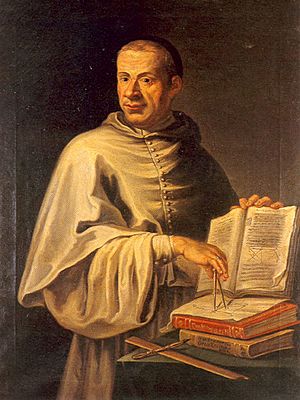Luigi Guido Grandi facts for kids
Quick facts for kids
Dom
Guido Grandi
|
|
|---|---|

Guido Grandi
|
|
| Born |
Francesco Lodovico Grandi
1 October 1671 |
| Died | 4 July 1742 (aged 70) |
| Resting place | San Michele in Borgo |
| Nationality | Italian |
| Other names | Dubeno Erimanzio |
| Known for | Studies on the rose curve Grandi's series |
| Parent(s) | Pietro Martire Grandi and Caterina Grandi (née Legati) |
| Scientific career | |
| Fields | mathematics |
| Institutions | University of Pisa |
| Notable students | Giammaria Ortes Giovanni Lami |
| Influences | |
| Influenced | Maria Gaetana Agnesi |
Guido Grandi was an Italian monk, priest, and a very smart person who worked as a mathematician and engineer. He was born on October 1, 1671, in Cremona, Italy, and passed away on July 4, 1742. He was known for his important work in mathematics, especially his studies on interesting curves and series.
Contents
Early Life and Education
Guido Grandi was born in Cremona, Italy. His birth name was Luigi Francesco Lodovico. When he was old enough, he went to a Jesuit school in his hometown.
After finishing his studies there in 1687, he decided to become a Camaldolese monk. He joined their group in Ferrara and took the name Guido. In 1693, he moved to a monastery in Rome. There, he continued his studies in philosophy and theology.
A year later, Grandi became a professor. He taught philosophy and theology at a monastery in Florence. It was during this time that he started to become very interested in mathematics. He studied it on his own.
In 1700, he became a philosophy professor in Rome. Later, he moved to Pisa to teach the same subject.
Becoming a Royal Mathematician
By 1707, Guido Grandi had become very famous for his math skills. The Grand Duke of Tuscany, Cosimo III de Medici, made him his official court mathematician. This was a very important job!
In this role, Grandi also worked as an engineer. He was put in charge of water systems for the whole region. He even helped drain a large area called the Chiana Valley. This was a big project to make the land more useful.
In 1709, he visited England. People there were very impressed with his work. He was even chosen to be a Fellow of the Royal Society. This is a special group for top scientists. In 1714, the University of Pisa made him a Professor of Mathematics. He stayed there until he passed away in 1742.
Amazing Math Discoveries
Guido Grandi made many important discoveries in mathematics.
The "Witch of Agnesi" Curve
In 1703, Grandi studied a special curve. He called it versiera, which means "to turn" in Latin. Later, another famous mathematician, Maria Gaetana Agnesi, also studied this curve.
When Agnesi's work was translated into English, there was a mistake. The Italian word for "turn" (vertere) sounded like "witch" (avversiera). Because of this, the curve became known as the "witch of Agnesi" in English! Grandi's work on this curve helped bring new ideas about calculus to Italy.
The Rose Curve and Grandi's Series
Grandi is also famous for his book Flores geometrici (1728). In this book, he studied the rose curve. This curve looks like a flower with petals. He called it rhodonea.
He is also well-known for something called Grandi's series. This is a special kind of math problem that looks at what happens when you add and subtract numbers in a certain way.
Grandi also helped with a new edition of Galileo Galilei's works. He added notes to Galileo's writings about how things move naturally.
Images for kids
See also
- Tommaso Perelli


